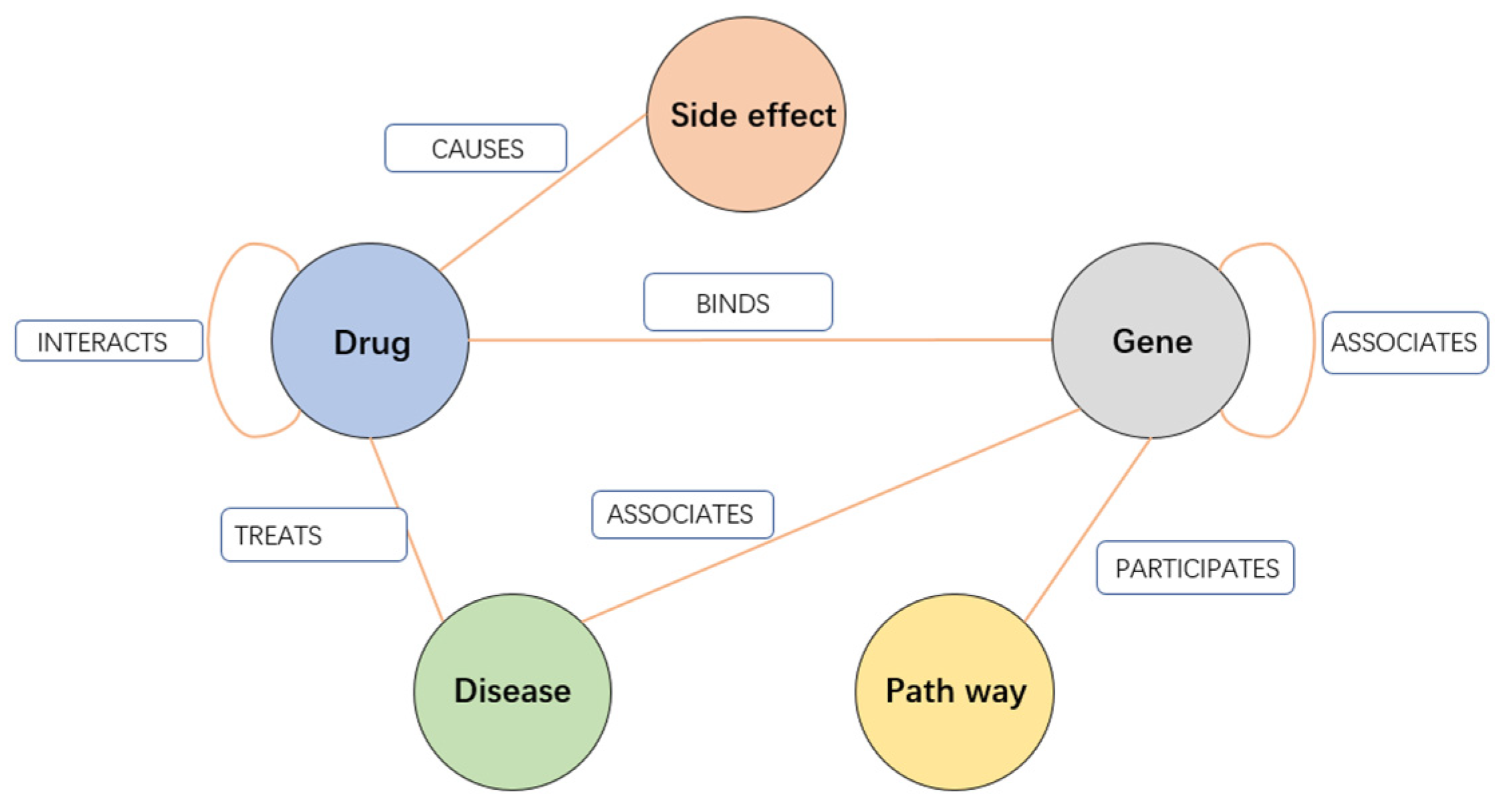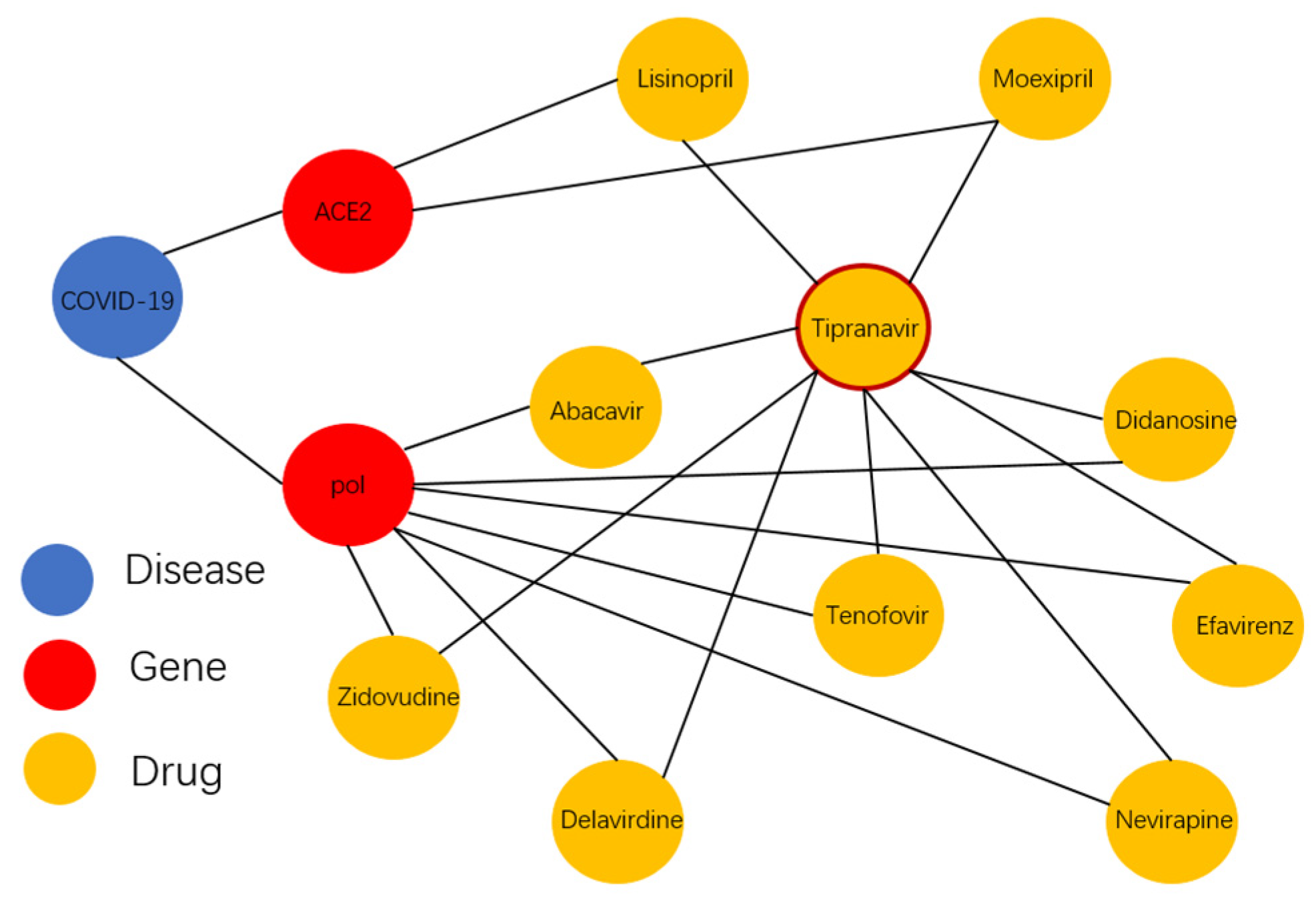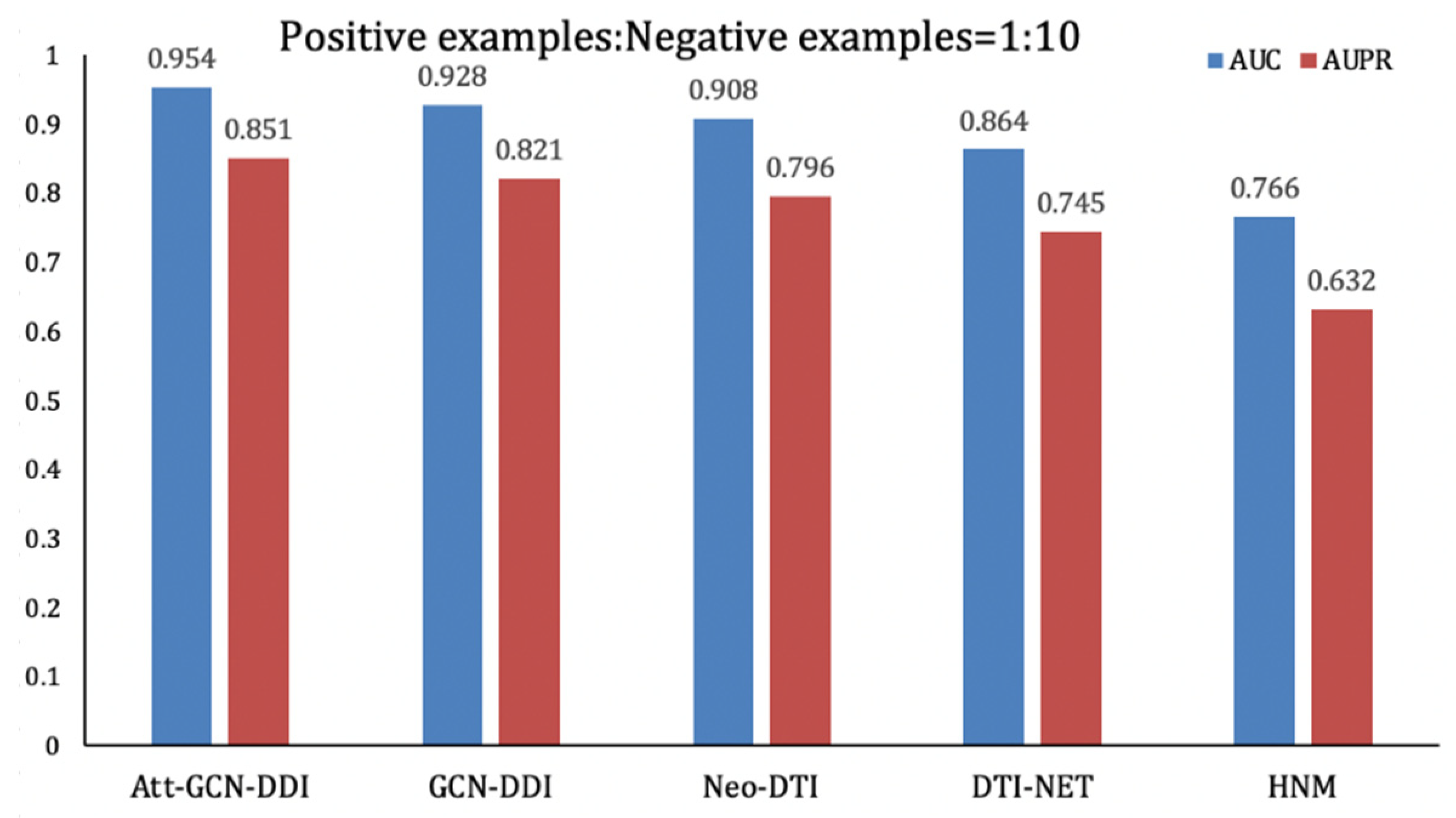Knowledge-Graph-Based Drug Repositioning against COVID-19 by Graph Convolutional Network with Attention Mechanism
Abstract
:1. Introduction
- (1)
- We gather and add the target of COVID-19 to our KG. Then, we select the related knowledge to construct a KG for COVID-19, which is applied to find the potential therapeutic drugs against COVID-19.
- (2)
- We propose a GCN-based model for drug repositioning on KG. The model can learn the topology around the disease effectively, which is utilized to predict new drugs for the disease.
- (3)
- We evaluate our method by predicting drugs for both ordinary diseases and COVID-19. Att-GCN-DDI finds five effective drugs against COVID-19, which have been proved in clinical treatment and outperforms five other baseline models in the drug repositioning for ordinary diseases. The experimental results confirm the strong predictive power of Att-GCN-DDI.
2. Related Work
3. Data Acquisition and Processing
3.1. The Drug KG
3.2. Acquisition of COVID-19 Information
3.3. Construction of the KG for COVID-19
4. Method
5. Experiments
5.1. DDI Prediction for COVID-19
5.1.1. Results
5.1.2. Case Study
5.2. DDI Prediction for Other Diseases
6. Discussion
Author Contributions
Funding
Institutional Review Board Statement
Informed Consent Statement
Data Availability Statement
Conflicts of Interest
References
- Velavan, T.P.; Meyer, C.G. The COVID-19 epidemic. Trop. Med. Int. Health 2020, 25, 278–280. [Google Scholar] [CrossRef] [PubMed] [Green Version]
- Velavan, T.P.; Meyer, C.G. Mild versus severe COVID-19: Laboratory markers. Int. J. Infect. Dis. 2020, 95, 304–307. [Google Scholar] [CrossRef] [PubMed]
- Ali, F.; El-Sappagh, S.; Islam, S.M.R.; Ali, A.; Attique, M.; Imran, M.; Kwak, K.-S. An intelligent healthcare monitoring framework using wearable sensors and social networking data. Futur. Gener. Comput. Syst. 2021, 114, 23–43. [Google Scholar] [CrossRef]
- Ali, F.; El-Sappagh, S.H.A.; Islam, S.M.R.; Kwak, D.; Ali, A.; Imran, M.; Kwak, K.S. A smart healthcare monitoring system for heart disease prediction based on ensemble deep learning and feature fusion. Inf. Fusion 2020, 63, 208–222. [Google Scholar] [CrossRef]
- Wan, F.; Hong, L.; Xiao, A.; Jiang, T.; Zeng, J. NeoDTI: Neural integration of neighbor information from a heterogeneous network for discovering new drug–target interactions. Bioinformatics 2018, 35, 104–111. [Google Scholar] [CrossRef] [PubMed]
- Luo, Y.; Zhao, X.; Zhou, J.; Yang, J.; Zhang, Y.; Kuang, W.; Peng, J.; Chen, L.; Zeng, J. A network integration approach for drug-target interaction prediction and computational drug repositioning from heterogeneous information. Nat. Commun. 2017, 8, 1–13. [Google Scholar] [CrossRef] [Green Version]
- Xue, H.; Li, J.; Xie, H.; Wang, Y. Review of Drug Repositioning Approaches and Resources. Int. J. Biol. Sci. 2018, 14, 1232–1244. [Google Scholar] [CrossRef] [Green Version]
- Mathur, A.; Loskill, P.; Shao, K.; Huebsch, N.; Hong, S.; Marcus, S.G.; Marks, N.C.; A Mandegar, M.; Conklin, B.R.; Lee, L.P.; et al. Human iPSC-based Cardiac Microphysiological System For Drug Screening Applications. Sci. Rep. 2015, 5, srep08883. [Google Scholar] [CrossRef] [Green Version]
- Zhao, T.; Hu, Y.; Valsdottir, L.R.; Zang, T.; Peng, J. Identifying drug–target interactions based on graph convolutional network and deep neural network. Briefings Bioinform. 2020, bbaa044. [Google Scholar] [CrossRef]
- Zhu, S.; Okuno, Y.; Tsujimoto, G.; Mamitsuka, H. A probabilistic model for mining implicit ’chemical compound-gene’ relations from literature. Bioinformatics 2005, 21, ii245–ii251. [Google Scholar] [CrossRef]
- Hewett, M.; Oliver, D.E.; Rubin, D.L.; Easton, K.L.; Stuart, J.M.; Altman, R.B.; Klein, T.E. PharmGKB: The Pharmacogenetics Knowledge Base. Nucleic Acids Res. 2002, 30, 163–165. [Google Scholar] [CrossRef] [PubMed]
- Chen, B.; Dong, X.; Jiao, D.; Wang, H.; Zhu, Q.; Ding, Y.; Wild, D.J. Chem2Bio2RDF: A semantic framework for linking and data mining chemogenomic and systems chemical biology data. BMC Bioinform. 2010, 11, 255. [Google Scholar] [CrossRef] [PubMed] [Green Version]
- Fu, G.; Ding, Y.; Seal, A.; Chen, B.; Sun, Y.; Bolton, E. Predicting drug target interactions using meta-path-based semantic network analysis. BMC Bioinform. 2016, 17, 1–10. [Google Scholar] [CrossRef] [Green Version]
- Fotis, C.; Antoranz, A.; Hatziavramidis, D.; Sakellaropoulos, T.; Alexopoulos, L. Network-based technologies for early drug discovery. Drug Discov. Today 2018, 23, 626–635. [Google Scholar] [CrossRef]
- Lavecchia, A. Machine-learning approaches in drug discovery: Methods and applications. Drug Discov. Today 2015, 20, 318–331. [Google Scholar] [CrossRef] [PubMed] [Green Version]
- He, T.; Heidemeyer, M.; Ban, F.; Cherkasov, A.; Ester, M. SimBoost: A read-across approach for predicting drug–target binding affinities using gradient boosting machines. J. Chemin. 2017, 9, 1–14. [Google Scholar] [CrossRef] [PubMed]
- Liu, Y.; Wu, M.; Miao, C.; Zhao, P.; Li, X.-L. Neighborhood Regularized Logistic Matrix Factorization for Drug-Target Interaction Prediction. PLoS Comput. Biol. 2016, 12, e1004760. [Google Scholar] [CrossRef] [PubMed]
- Mei, J.-P.; Kwoh, C.-K.; Yang, P.; Li, X.-L.; Zheng, J. Drug–target interaction prediction by learning from local information and neighbors. Bioinformatics 2013, 29, 238–245. [Google Scholar] [CrossRef]
- Sang, S.; Yang, Z.; Liu, X.; Wang, L.; Lin, H.F.; Wang, J.; Dumontier, M. GrEDeL: A Knowledge Graph Embedding Based Method for Drug Discovery from Biomedical Literatures. IEEE Access 2019, 7, 8404–8415. [Google Scholar] [CrossRef]
- Mohamed, S.K.; Nováček, V.; Nounu, A. Discovering Protein Drug Targets Using Knowledge Graph Embeddings. Bioinformatics 2019, 36, 603–610. [Google Scholar] [CrossRef]
- Pei, J.; Yin, N.; Ma, X.; Lai, L. Systems Biology Brings New Dimensions for Structure-Based Drug Design. J. Am. Chem. Soc. 2014, 136, 11556–11565. [Google Scholar] [CrossRef] [PubMed]
- Olayan, R.S.; Ashoor, H.; Bajic, V.B. DDR: Efficient computational method to predict drug–target interactions using graph mining and machine learning approaches. Bioinformatics 2018, 34, 1164–1173. [Google Scholar] [CrossRef] [Green Version]
- Zheng, X.; Ding, H.; Mamitsuka, H.; Zhu, S. Collaborative matrix factorization with multiple similarities for predicting drug-target interactions. In Proceedings of the 19th ACM SIGKDD International Conference on Knowledge Discovery and Data Mining, Chicago, IL, USA, 11–14 August 2013; ACM Inc.: New York, NY, USA, 2013; pp. 1025–1033. [Google Scholar] [CrossRef]
- Wang, W.; Yang, S.; Zhang, X.; Li, J. Drug repositioning by integrating target information through a heterogeneous network model. Bioinformatics 2014, 30, 2923–2930. [Google Scholar] [CrossRef] [PubMed]
- Whirl-Carrillo, M.; McDonagh, E.M.; Hebert, J.M.; Gong, L.; Sangkuhl, K.; Thorn, C.F.; Altman, R.B.; Klein, T.E. Pharmacogenomics knowledge for personalized medicine. Clin. Pharmacol. Ther. 2012, 92, 414–417. [Google Scholar] [CrossRef] [PubMed]
- Yang, H.; Qin, C.; Li, Y.H.; Tao, L.; Zhou, J.; Yu, C.Y.; Xu, F.; Chen, Z.; Zhu, F.; Chen, Y.Z. Therapeutic target database update 2016: Enriched resource for bench to clinical drug target and targeted pathway information. Nucleic Acids Res. 2016, 44, D1069–D1074. [Google Scholar] [CrossRef]
- Kanehisa, M.; Araki, M.; Goto, S.; Hattori, M.; Hirakawa, M.; Itoh, M.; Katayama, T.; Kawashima, S.; Okuda, S.; Tokimatsu, T.; et al. KEGG for linking genomes to life and the environment. Nucleic Acids Res. 2008, 36, D480–D484. [Google Scholar] [CrossRef]
- Law, V.; Knox, C.; Djoumbou, Y.; Jewison, T.; Guo, A.C.; Liu, Y.; Maciejewski, A.; Arndt, D.; Wilson, M.; Neveu, V.; et al. Drugbank 4.0: Shedding new light on drug metabolism. Nucleic Acids Res. 2014, 42, D1091–D1097. [Google Scholar] [CrossRef] [Green Version]
- Kuhn, M.; Letunic, I.; Jensen, L.J.; Bork, P. The SIDER database of drugs and side effects. Nucleic Acids Res. 2016, 44, D1075–D1079. [Google Scholar] [CrossRef]
- Sharp, M.E. Toward a comprehensive drug ontology: Extraction of drug-indication relations from diverse information sources. J. Biomed Semant. 2017, 8, 2. [Google Scholar] [CrossRef] [Green Version]
- Zhu, Y.; Che, C.; Jin, B.; Zhang, N.; Su, C.; Wang, F. Knowledge-driven drug repurposing using a comprehensive drug knowledge graph. Health Inform. J. 2020. [Google Scholar] [CrossRef]
- Wu, C.; Liu, Y.; Yang, Y.; Zhang, P.; Zhong, W.; Wang, Y.; Wang, Q.; Xu, Y.; Li, M.; Li, X.; et al. Analysis of therapeutic targets for SARS-CoV-2 and discovery of potential drugs by computational methods. Acta Pharm. Sin. B 2020, 10, 766–788. [Google Scholar] [CrossRef] [PubMed]
- Liu, Q.; Wang, X. Strategies for the development of drugs targeting novel coronavirus 2019-nCoV. Acta Pharm. Sin. B 2020, 55, 181–188. [Google Scholar] [CrossRef]
- COVID-19 Dashboard|DrugBank Online. Available online: https://www.drugbank.ca/covid-19 (accessed on 14 November 2020).
- Zhang, C.; Chen, S.; Zhang, J.; Guo, Y. Analysis of chemical drugs applied for clinical trial for the treatment of COVID-19. Acta Pharm. Sin. B 2020, 55, 355–365. [Google Scholar] [CrossRef]
- Wei, P. Iagnosis and Treatment Protocol for Novel Coronavirus Pneumonia (Trial Version 7). Chin. Med. J. 2020, 133, 1087–1095. [Google Scholar] [CrossRef]





| Entity Type | Drug | Disease | Gene | Side Effect | Pathway |
|---|---|---|---|---|---|
| Number | 1470 | 752 | 1741 | 274 | 53 |
| Relation Type | Drug–Disease | Drug–Gene | Gene–Pathway | Drug–Drug | Drug–Side Effect | Gene–Gene | Disease–Gene |
|---|---|---|---|---|---|---|---|
| Number | 1659 | 1898 | 62 | 921 | 1432 | 263 | 877 |
| DrugBank Id | Drug Name | Source of Clinical Feasibility |
|---|---|---|
| DB00300 | Tenofovir | Published medical literature [35] |
| DB01601 | Lopinavir | Experimental drugs for COVID-19 in DrugBank [34] |
| DB01264 | Darunavir | Experimental drugs for COVID-19 in DrugBank [34] |
| DB00503 | Ritonavir | Published Treatment Protocol in China [36] |
| DB00811 | Ribavirin | Published Treatment Protocol in China [36] |
Publisher’s Note: MDPI stays neutral with regard to jurisdictional claims in published maps and institutional affiliations. |
© 2021 by the authors. Licensee MDPI, Basel, Switzerland. This article is an open access article distributed under the terms and conditions of the Creative Commons Attribution (CC BY) license (http://creativecommons.org/licenses/by/4.0/).
Share and Cite
Che, M.; Yao, K.; Che, C.; Cao, Z.; Kong, F. Knowledge-Graph-Based Drug Repositioning against COVID-19 by Graph Convolutional Network with Attention Mechanism. Future Internet 2021, 13, 13. https://doi.org/10.3390/fi13010013
Che M, Yao K, Che C, Cao Z, Kong F. Knowledge-Graph-Based Drug Repositioning against COVID-19 by Graph Convolutional Network with Attention Mechanism. Future Internet. 2021; 13(1):13. https://doi.org/10.3390/fi13010013
Chicago/Turabian StyleChe, Mingxuan, Kui Yao, Chao Che, Zhangwei Cao, and Fanchen Kong. 2021. "Knowledge-Graph-Based Drug Repositioning against COVID-19 by Graph Convolutional Network with Attention Mechanism" Future Internet 13, no. 1: 13. https://doi.org/10.3390/fi13010013
APA StyleChe, M., Yao, K., Che, C., Cao, Z., & Kong, F. (2021). Knowledge-Graph-Based Drug Repositioning against COVID-19 by Graph Convolutional Network with Attention Mechanism. Future Internet, 13(1), 13. https://doi.org/10.3390/fi13010013






